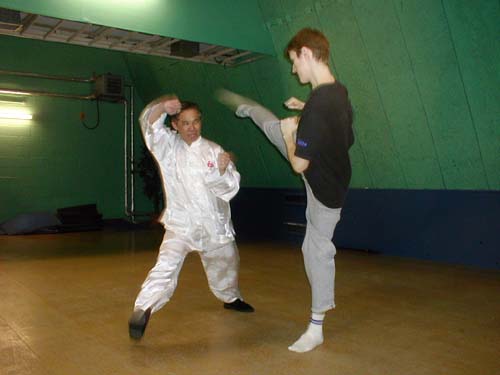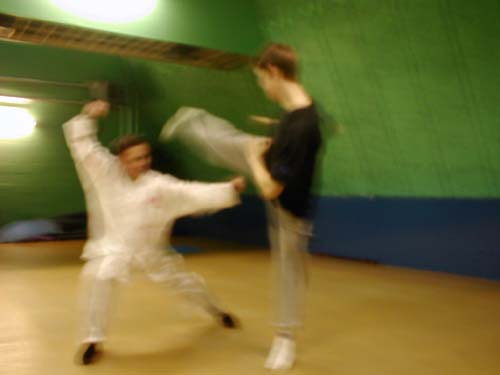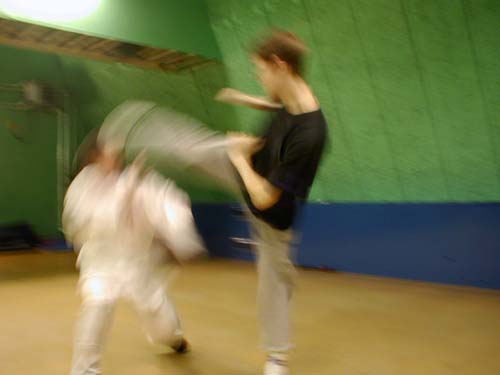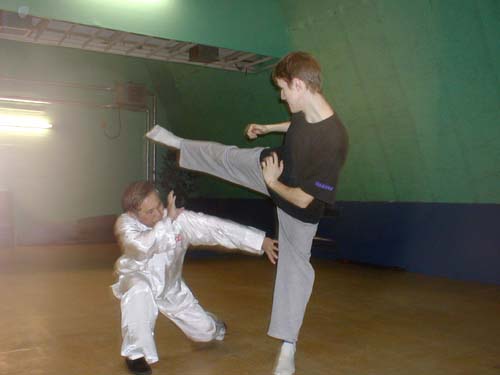March 2004 (Part 3)
SELECTION OF QUESTIONS AND ANSWERS

Michael Durkin of England executes a Bruce Lee's kick at Sifu Wong. Sifu Wong is in the process of moving forward diagonally to avoid the kick.
Question 1
Do you believe forms are a very important aspect of martial art for combat? I have been told that Bruce Lee's art was formless. He never had a certain real way to apply to a certain combat situation. Can you please give your view on this?
— Chris, Australia
Answer
When one says that Bruce Lee's art was formless, he actually means that Bruce Lee did not use traditional kungfu forms in his solo practice as well as fighting. But it was not true that Bruce Lee did not use any forms.
It was also not true that he did not have a particular way to respond to a combat situation. Whether his responses were spontaneous or premeditated, Bruce Lee always responded in his characteristic ways.
Anyone seeing Bruce Lee fight or seeing someone who fight like Bruce Lee, could readily tell from the fighting forms that it was Bruce Lee's style. He would not say it was the fighting style of Taijiquan or Wrestling. How did he tell the style? From his fighting forms. If Bruce Lee's fighting forms were not generalized enough to constitute a style of his own, if he, for example, butted like a sumo wrestler in one situation, then swung his arms widely like an untrained person in another situation, no one would be able to say that that was Bruce Lee's style.
Bruce Lee also had recognizable ways of attack and defence. If you threw a punch at him, he would dodge, then counter-attack with his typical kicks. He would not, for example, roll onto the ground to grab your legs. If he attacked you, he also had predictable moves. He would throw some feint jabs, then attack you with his typical kicks. He would not, for example, move in with a tiger-claw or a Judo throw.
My philosophy and practice of martial art are very different from those of Bruce Lee's. To me forms are very important for combat as well as for solo training. And the martial art forms I favour the most are those from Shaolin Kungfu and Taijiquan. I think they are the best. In my opinion, Bruce Lee's forms contain many weaknesses.
If I were to kick like Bruce Lee, I would expose my groin for serious counter-attack, offer my extended leg to be fractured, position myself where my balance and mobility would be affected, and where I could not effectively use other parts of my body for attack or defence, need time to recover before I could use another technique, and most significant of all I could not make the best use of my stances and internal force for which I have spent much time in training.
On the other hands, the Shaolin and Taijiquan forms are evolved from centuries of actual effective fighting. By using them I benefit from the techniques and skills past masters discovered and passed down to us. It would be silly of me if I discarded such a treasure and tried to invent fighting forms myself.
Bruce Lee certainly had preferred ways to respond to certain combat situations, although I do not know whether these preferred responses were made at the spur of the moment, or had been rehearsed many times beforehand. Judging from Bruce Lee's philosophy, especially his belief that combat situations were never the same each time and thus his disdain for pre-arranged sparring, I would think his responses were not rehearsed before hand.
Our approach in Shaolin Wahnam is different. We rehearse preferred responses to particular attacks many, many times before putting them into combat application. If an opponent attacks us with a right Bruce Lee kick, for example, we would not think, “Now which technique from my repertoire I should use to counter this kick”, but spontaneously move our right leg diagonally forward and strike his groin with our left fist using the Wahnam Taijiquan pattern “Bend Bow to Shoot Tiger” if we want to be nasty, or squat down and grip his left knee with our left tiger-claw using the Shaolin pattern “Catch Tiger in Mountain” if we “let mercy flow from our hands”.
We could do this effectively because we have trained the preferred responses many, many times. And this is only possible if we place importance on traditional kungfu forms.
Question 2
I suffered from RSI (Repeated Stress Injury) because of computer use and I believe bad lifestyle in general. Although the RSI itself was a painful experience, it has been the best thing that ever happened to me because it lead me to discover Tai Chi and Chi Kung, as well as Eastern philosophy in general.
— Hubert, England
Answer
Often what one initially though was a misfortune could turn out to be a blessing in disguise. A few great kungfu and chi kung masters in history started to learn their art because they were initially very weak or sick.
A healthy lifestyle is important. If his lifestyle is bad, such as drinking and gambling excessively and constantly harbouring evil thoughts, even practicing high-level chi kung daily will not make him healthy, happy and peaceful.

Sifu Wong counter-strikes with the Taijiquan pattern, “Bend Bow Strike Tiger”, just as Michael's kick is spent. Good timing is essential.
Question 3
Since then I have been practicing Tai Chi extensively. I have found an instructor that I think is very competent. After 5 months of practice, my wrist problem was almost completely healed. I was progressing, and enjoying it more and more.
Answer
Congratulations for having a good teacher. It is not easy to get good teachers nowadays. Many Tai Chi and chi kung teachers today do not really know what they are teaching is not Tai Chi Chuan or chi kung.
For example, they do not know that Tai Chi Chuan is an internal, martial art, or what chi is. This is evident from the fact that there is nothing internal or martial in the Tai Chi they teach, and they and their students never have any experience of chi.
Once during my public talk in Spain on chi kung, a woman from the audience argued with me saying that Tai Chi Chuan was not a martial art. She said she and hundreds of Tai Chi teachers, including Chinese, had been teaching it as a gentle exercise. On another occasion, a Chinese Taiji (Tai Chi) instructor sent by the Chinese government to teach Taiji in Malaysia, insisted that there was no such thing as chi in Taijiquan! He also admitted that he could not use his Taiji for self defence.
Tai Chi Chuan and chi kung have degraded to such a ridiculous, or comical, situation today that the very few who still advocate Tai Chi Chuan as an internal, martial art and chi kung as an art of energy capable of overcoming so-called incurable diseases — which were established facts in Tai Chi Chuan and chi kung history — are sometimes accused of being liars or charlatans.
The vast majority of those who practice Taiji and chi kung today, including in contemporary China, practice and promote them as gentle, physical exercise. They also hold key positions in national and international Taiji and chi kung organizations, and sometimes decide on who can or cannot teach these arts. If the general public or government bodies wish to have any official information on Tai Chi Chuan or chi kung, they usually turn to these key personnel for advice.
Question 4
However, I was still lacking energy for daily life. Although the Tai Chi class includes some Chi Kung, I have decided to focus on Chi Kung to improve my daily life.
Answer
Genuine Tai Chi Chuan itself is chi kung. Ideally, if you practice genuine Tai Chi Chuan, there is no need to incorporate other chi kung exercises into it, just as there is no need to incorporate fighting techniques from other styles, such as Taekwondo kicks, or training methods from other martial arts, such as using boxing gloves in sparring, because Tai Chi Chuan is a complete art itself.
As Tai Chi Chuan is a martial art, the level of energy trained in Tai Chi Chuan is generally higher than that in other types of chi kung like Ba Duan Jin and Soaring Crane. The rationale will become clear if you realize that to be a martial artist you need not just to be healthy, but also to have a lot of energy to fight well and to make quick decisions in combat. In other words, if the amount of energy needed to maintain health is x, the amount of energy needed to be a competent martial artist is more than x.
However, situations are seldom ideal. Hence, wherever necessary, incorporating compatible chi kung exercise into your Tai Chi Chuan training is advisable.
Question 5
I have started an extra class of Chi Kung, run by a student of Master Lam Kam Chuen. I have also bought Master Lam's book, “The Way of Energy”.
Answer
Master Lam Kam Chuen's specialty is zhan zhuang, or stance training. In my opinion, his excellent book, “The Way of Energy”, is the single most important book in introducing and explaining to the public the philosophy and practice of zhan zhuang, contributing greatly to students of both chi kung and martial arts.

Michael executes another Bruce Lee's kick at Sifu Wong, who moves forward diagonally to dodge the kick. Much skill, especially perfect timing, is needed for such a move.
Question 6
Master Lam's book teaches mainly about Zhan Zhuang and Ba Duan Jin. That is also the Chi Kung we practice in my Tai Chi class.
Answer
Zhan zhuang, or stance training, is a generic terms. There are many types of zhan zhuang. The “zhuang” or stance Master Lam emphasizes in his remarkable book is the “Three-Circle Stance”, which, if I remember correctly, he calls “Hugging a Tree”.
Other kungfu styles may favour other stances for their internal force training. In Southern Shaolin, for example, the most favoured stance is “Golden Bridge”, and in Hsing Yi Kungfu the “Three-Treasure Stance”.
The “Three-Circle Stance” or “Hugging a Tree” as taught by Master Lam, is also the most favoured stance for internal force training in Tai Chi Chuan. It is a fundamental part of Tai Chi Chuan training. The “Three-Circle Stance” is so popular in Tai Chi Chuan that it is in fact sometimes known as the “Tai Chi Stance”, though this is inaccurate because the “Three-Circle Stance” is also found in other styles of kungfu.
Ba Duan Jin, or Eight Pieces of Brocade, however, is not an integral part of Tai Chi Chuan, but it is very popularly practiced in many schools of chi kung. In our school, Shaolin Wahnam, the first eight patterns of our Shaolin Eighteen Lohan Hands correspond exactly to the eight patterns of the Eight Pieces of Brocade.
Question 7
In his book Master Lam advices students to start Zhan Zhuang, first for 5 minutes a day, and to increase slowly to up to 20 minutes (including 5 postures). He also advices them to start Ba Duan Jin about 3 months after beginning the training, and to do it as a preparation for Zhan Zhuang.
However while reading some of your questions/answers, I found out that you advice students not to do both at the same time, but rather do Ba Duan Jin one day, and Zhan Zhuan the other day.
I am really worried about doing those exercises wrongly, and although I am doing this with an instructor's advice, having 2 masters with a different opinion confuses me.
Answer
I cannot remember the exact background situation where my advice was given, but certainly I was not referring to Master Kam's advice.
Different masters teach differently, and the same master may teach differently in different situations. Master Kam must have good reasons for his advice, and as he is a zhan zhaung specialist, his advice is invaluable.
My approach is different. If all other things were equal, I would recommend first practicing only Ba Duan Jin for a few months, only then commence zhan zhuang. Ba Duan Jin will clear any energy blockage the student may have. This will not only enable the subsequent zhan zhuang training to be safe, but also enhance its result. This is an example of “starting later but arriving earlier”.
Suppose John and Peter wish to develop internal force via zhan zhaung. John starts straight away with zhan zhaung in January but Peter starts zhan zhaung only in April, using the first three months to practice Ba Duan Jin. By the middle of the year, Peter is not only healthier, he may also have more internal force than John. Why is this so, when John has trained zhan zhuang for six months, whereas Peter has trained for only three?
John's zhan zhuang adds energy to his body system, but because of his blockage, the newly added energy cannot flow smoothly. Instead it could make him physically tensed, emotionally aggressive, mentally anxious, and spiritually unstable. His internal force is pent up inside his body.
On the other hand, Peter cleared his blockage first with Ba Duan Jin, so that the newly added energy from his zhan zhuang training can flow smoothly. He becomes physically relaxed, emotionally calm, mentally fresh, and spiritually joyful. His internal force is alive.
These are not just empty words. When we say our internal force is alive, for example, we know what we are saying, although other people who do not have such an experience may not really understand what we mean.
And in Shaolin Wahnam, philosophy comes after experience. In other words, we do not merely speculate that if one locks up his energy he would feel unsettled and aggressive, but if he lets his energy flow he would feel fresh and joyful. While past masters have left such teachings to us in their writings, we also learn them first hand from our experience. We learn, for example, that when we tense our muscles (causing energy blockage) we feel oppressive inside, when we relax and let our energy flow we feel powerful and joyful.
Question 8
Should I carry on what I have started and do both Ba Duan Jin and Zhan Zhuan (while progressively increasing the time of the Zhan Zhuan postures)?
Answer
There is no one definite answer. A number of factors need to be taken into consideration. Even a question involving a physical action like “Should I cook the fish and eat it?” needs consideration over such factors like whether you are hungry, whether the fish is poisonous, or whether cooking is permissible at that place and moment, the more it is so with a question involving a training where many factors are internal.
Hence, you would appreciate why I have often stressed that one will derive the best benefits only when he trains with a master. The master with his wide experience and knowledge will be able to guide his student to derive the best benefits. Often the gap of benefits derived by the same student training the same method but between a master and a mediocre instructor is huge.
If you have relatively little blockage, can perform the two exercises reasonably well, and are quite contented so long as you can get some benefit, you can do both Ba Duan Jin and zhan zhuang at the same time. Even if you sustain some injury from your zhan zhuang, your Ba Duan Jin training can alleviate the problem.
If you are new to chi kung, have no living instructor to supervise you, and cannot relax easily, it is advisable to practice Ba Duan Jin for a few months first before starting zhan zhuang. Even if you had no blockage, the Ba Duan Jin training will help you to relax. Being able to relax is very important in zhan zhaung. If you are tensed while performing zhan zhuang — physically, emotionally, mentally or spiritually — you would get harmful effects rather than benefits, and you are unlikely even to realize your wrong practice.

This time Sifu Wong counter-attacks with a Shaolin pattern, “Hungry Tiger Returns to Den”, snatching or gripping Michael's standing knee with a tiger-calw. This is a compassionate counter, without hurting the opponent seriously. Here, as in the earlier counter-attack, Sifu Wong exploits Michael's innate weakness of immobility as he executes a kick.
Question 9
I have read on your site that prior to starting Zhan Zhuan practice you should clear you energy blockage. However, Master Lam says in his book that Zhan Zhuang could actually clear blockage!
Answer
What Master Lam has said is true. Circulating energy (called “xing qi” in Chinese) and building energy (“yang qi”) are the two fundamental tasks of all chi kung — including low level chi kung, so long as it is genuine chi kung and not gentle physical exercise.
Low level chi kung would take a long time (in matters of years) to accomplish the tasks, whereas high level chi kung would accomplish them in a short time (in weeks). Gentle physical exercise would never accomplish these tasks even if practiced for life. Today a lot of chi kung is being practiced as gentle physical exercise.
Relatively speaking, circulating energy involves clearing blockage, whereas building energy involves increasing force. Different types of chi kung exercises have different emphasis on these two fundamental tasks. Roughly the ratio of clearing blockage to increasing force of the following chi kung exercises are as follows.
- Self-Manifested Chi Movement 9-1
- Ba Duan Jin 7-3
- Zhan Zhuang 1-9.
But if you have a sound understanding of chi kung philosophy and appropriate skills to control various training factors, you can vary the ratio of any chi kung exercise at will. For example, students at my intensive courses can change the ratio of zhan zhuang emphasis from 10% clearing blockage and 90% building force to 90% clearing blockage and 10% building force, or to any ration they like.
Of course, if you do not have the skills and techniques, or worse are not even aware of the significance and relationship of these two chi kung aspects, you will be at the mercy of random factors which may sometimes cause you harm without your knowing. You may, as it is not uncommon among many uninformed practitioners, practice zhan zhuang diligently thinking that it will bring you much benefit as it is a very powerful exercise, not knowing the more you practice the more you may harm yourself.
Question 10
I do know I have some major energy blockage, so I'm starting to wonder if Zhan Zhuan is what I need. I have dedicated much time and efforts to practice it regularly, so I am now worrying that I am not doing the right thing.
Answer
Unless you had the skills and techniques to vary the ratio between clearing and building as mentioned above, you should not practice zhan zhuang if you have major energy blockage.
The ideal type of chi kung to clear blockage is Self-Manifested Chi Movement. But Self-Manifested Chi Movement should be learnt personally from a master or at least a competent instructor. If practiced wrongly, it can be risky.
Your best choice, therefore, is Ba Duan Jin. If you cannot learn from a living teacher, you can learn it from a good book. The result will be far less, of course, but it is relatively safe even if you make some mistakes, unless you have gone in too deeply or the mistakes are too serious.
Question 11
Because nowadays most of us can't study with a master, what would be your advice to achieve an efficient self study (along with regular attendance of a serious class), especially when you read different advices and methods from different masters?
Answer
When you and other people say that you can't study with a master, implying that you don't have the opportunity, what you really mean is that you are unwilling or too lazy to make the required effort to learn from a master. Never before have opportunities to learn from masters been as plentiful and easily available as now!
From a historical perspective, what I offer the public is almost ridiculous! For a thousand or a thousand and five hundred dollars, I offer what in the past people would pay a fortune to acquire if given a chance. Students will acquire skills in a week what they may never acquire elsewhere in 20 years, and if they are dissatisfied with the teaching they do not pay any fees.
Many other masters have also made their teachings easily available. When compared to the fees charged by bogus instructors, of course the masters' fees are substantial, but when compared to fees charged by experts in other disciplines, their fees are more than reasonable. Some masters charge only nominal fees, and a few even teach for free.
Of course you have to find out where they are and go to them, and treat them respectfully as masters. You don't expect them to turn up at your doors to teach you for the amount you would pay for your dinner.
Irrespective of whether you learn from a master, a book or any other sources, the inevitable path to proficiency in any art is practice, practice and practice.
But mere diligent practice is inadequate. You have to define the aims and objectives of your practice, ascertain that the methods of your practice are appropriate, the way you practice is correct, and your practice brings desirable results.
If you attend a regular class, check with your instructor and classmates the progress of your practice. Seek advice from masters if possible, evaluate it and follow it when applicable. If the masters' advice varies, which may sometimes be the case as different masters have different philosophy and training background, consider the different advice carefully and make your decisions wisely.
LINKS
Selected Reading
- Bullshit in Chinese Martial Art? — Grandmaster Kai Uwe Jettkandt
- Combat Sequences 13 — Fell Tree with Roots
- Taijiquan Defence Against Fundamental Attacks
- Seeing Things Clearly and in a Completely Different Way
